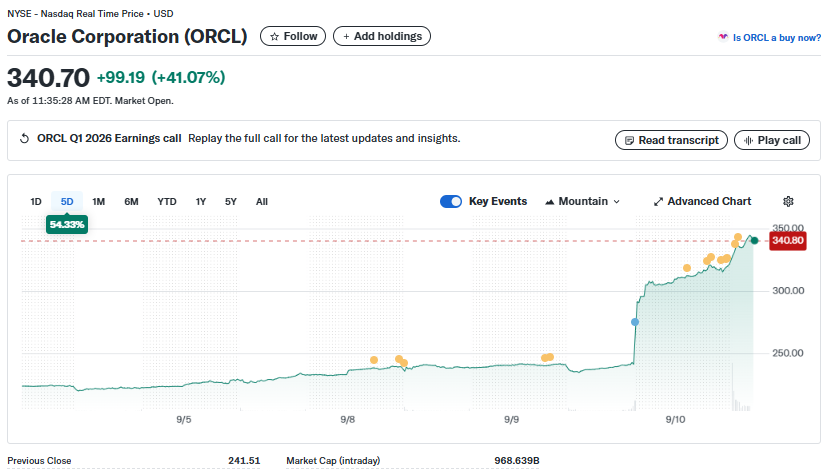Oracle Corporation (NYSE: ORCL) stunned markets this week as its stock surged another 42% on Wednesday morning, extending an already historic rally.
The gains come on the heels of Tuesday’s 20% after-hours spike following the company’s first-quarter fiscal 2026 earnings call.
Despite missing Wall Street’s consensus estimates for earnings and revenue, investors are doubling down on Oracle’s future cloud prospects, sending its market capitalization soaring past $870 billion and marking its most dramatic surge since the late 1990s.

Oracle’s biggest driver is its bold projection to achieve $144 billion in annual cloud infrastructure revenue by 2030, a fourteen-fold jump from its current $10 billion run rate. If realized, this would significantly disrupt the existing cloud hierarchy dominated by Amazon Web Services (AWS), Microsoft Azure, and Google Cloud.
Currently, Oracle commands only about 3% of global market share compared with AWS at 30%, Azure at 20%, and Google Cloud at 13%. But its trajectory suggests it could be on course to capture a much larger portion of what analysts expect to be a $400 billion global market by 2025.
Oracle CEO Safra Catz highlighted that the company signed four multi-billion-dollar contracts with three customers in the last quarter alone, underscoring growing enterprise trust in its infrastructure.
A central catalyst behind Oracle’s market rally is its deepening involvement in artificial intelligence. In the quarter, OpenAI signed a deal to develop 4.5 gigawatts of U.S. data center capacity with Oracle.
This partnership places Oracle at the heart of the AI compute boom, allowing it to supply critical infrastructure to one of the most influential AI developers in the world.
Unlike rivals who own vast networks of real estate and physical data centers, Oracle has chosen a partnership-heavy model. By focusing on its proprietary technologies, Oracle can rapidly scale capacity without incurring the same capital costs as AWS or Microsoft. Analysts note that hyperscalers often “offload” capacity needs onto Oracle, effectively making it a hidden backbone of the industry.
Investors are also responding to Oracle’s staggering growth in Remaining Performance Obligations (RPO), which jumped 359% year-over-year to $455 billion.
RPO represents contracted revenue yet to be recognized, effectively a forward-looking snapshot of Oracle’s future sales pipeline. The scale of this increase suggests that Oracle has locked in massive, long-term demand, further justifying its ambitious forecasts.
D.A. Davidson analyst Gil Luria noted that some of this growth comes from large technology firms relying on Oracle to serve their own customers, an unusual dynamic that gives Oracle both direct enterprise clients and indirect exposure to competitors’ ecosystems.
The optimism fueling Oracle’s rally speaks to a broader shift in how investors are viewing the cloud market. For decades, Oracle was seen as a legacy enterprise software provider, often trailing behind its peers in cloud adoption. Today, however, it is positioning itself as a critical enabler of AI-driven infrastructure.
If Oracle can deliver on its $144 billion revenue goal, the company could leapfrog into the top tier of global cloud players by the end of the decade. While skeptics warn that the target is one of the most ambitious in enterprise technology history, Wall Street’s current enthusiasm suggests investors are increasingly willing to give Oracle the benefit of the doubt.
The post Oracle Corporation (ORCL) Stock: Extends Rally, Now Up 42% as Wall Street Embraces $144B Cloud Ambition appeared first on CoinCentral.
Also read: Spotify : l’audio sans perte arrive enfin sur la plateforme !